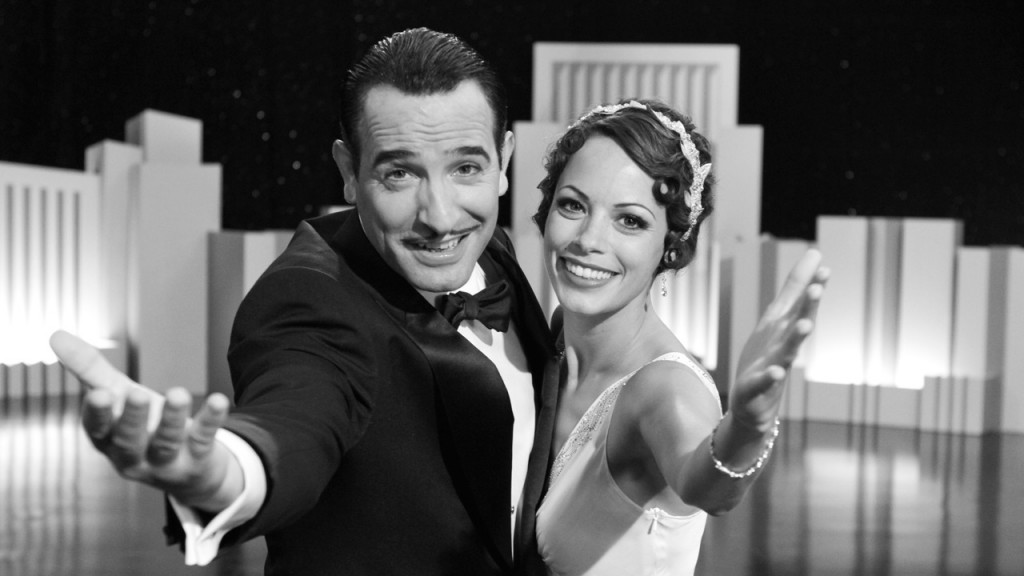Mia Wallace: Don’t you hate that?
Vincent: What?
Mia: Uncomfortable silences. Why do we feel it’s necessary to yak about bullshit in order to be comfortable?
Vincent: I don’t know. That’s a good question.
Mia: That’s when you know you’ve found somebody special. When you can just shut the f**k up for a minute and comfortably enjoy the silence.
— Pulp Fiction
Last week I had the pleasure of viewing the crowd pleasing critical darling The Artist. The film is a bold, artsy stroke hidden in a big-hearted familiar story, or maybe it’s the other way around? It’s been nominated for so many awards and has such a high rating on Rotten Tomatoes that cooler than thou critics will not be able to resist trying to take it down a notch, but don’t listen to them. It’s a thoroughly entertaining, fundamentally sweet and beautifully constructed picture.
The black and white mostly silent French film directed by Michel Hazanavicius stars Jean Dujardin as silent film star George Valentin and Bérénice Bejo as Peppy Miller. The story takes place in Hollywood between 1927 and 1932 and focuses on Valentin’s decline and Miller’s rise, as silent cinema falls out of fashion and is replaced by the talkies. Less a faithful paean to the Silent Era of cinema and more a pastiche of big studio Hollywood filmmaking with joyful, sometimes anachronistic, references to Singin’ in the Rain, Citizen Kane, A Star is Born, Billy Wilder, Vertigo and many other films. Hazanavicius doesn’t waste a single frame (I could write paragraphs about the gorgeously constructed shots in stairwells alone), but the film wears its references and artistry lightly. Anchored by the warm vibrant performances of the actors, it never feels pretentious or overwrought. Dujardin is brilliant, like Douglas Fairbanks, Maurice Chevalier and Gene Kelly rolled into one tuxedoed package. His easy smile and explosive masculine grace, particularly reminiscent of Kelly, are given depth with the modern subtlety and naturalism of his performance. Dujardin and Bejo have real chemistry and each is immensely likeable playing types — self-absorbed, but sweet charmer and perky doe-eyed beauty — that are unbearable in so many films. The two are supported by the always fantastic John Goodman, James Cromwell and Penelope Ann Miller, in a humorous turn as Valentin’s frustrated wife. “The Artist” drags a bit when it shifts from its early romantic-comedy mode to the melodrama of George’s fall into alcoholism and bankruptcy (while Peppy becomes a hugely successful sassy flapper It-girl), but the film never loses its overwhelming charm and ease. The ending is pitch-perfect and let me just add that there are tap-dancing numbers (!). Reason enough to recommend it.
But for all my geek love of film references and pure enjoyment of the acting and beauty of the film, I was most moved by the experience of watching a film with almost no sound and the feeling that I was participating in an event. I have a high threshold for artsy experimental films, 1930s screwball comedies and old Hollywood musicals. I’ve watched silent films before, but on my own, on my laptop, in snippets and fits and starts, but I’ve never seen one in a theater. Sitting in the dark, I became so conscious of sound. Conscious of the way the rest of the audience, like me, seemed to have slowed its breathing down, had stopped opening sweets, crunching on popcorn or sipping their wine. I could hear people shifting in their seats, crossing and uncrossing their legs. It was uncomfortable at first, even with my open mind and high threshold for weirdness, but then the film eased me into the quiet — taught me how to watch it with each beautiful frame. I slowed down and let myself be swept away by the magic of it in a way that I haven’t experienced for years. I was left feeling invigorated, in love with movies all over again and like I’d found something special.


Heidi, I took my 15 year old son to see it. He was adamant that he would hate it. “I was really glad I was wrong dad. I loved it.” And so was your review.
“The Artist” inspired me to start watching some old Buster Keaton films while on the treadmill. I’d forgotten how the silent film requires a more nuanced visual style, obviously, a more physical projection of character, analgous to the aural projection necessary for the stage. It seemed that “The Artist” also relied on clever scene cutting rather than clever dialogue, more on visual, not physical, humor. While “The Artist” will not likely begin a fad of shooting silent movies, it might influence the visual style of movies in the next couple of years. As John Goodman’s characters says: “perfect!”
Oops. “And so was your review” was supposed to be at the very end after “perfect!”
I really really want to see this. We’re having a Pretentious Movie Night soon with the local Mormon Stories folks in Phoenix, and we’re deciding between this one and The Descendants. You’ve swayed me this direction!
Ooh, I love Pretentious Movie Nights. As such, I’m also anxious to see The Descendants.) Let us know how it goes (althoughThe Artist is too sweet to be fully pretentious.)